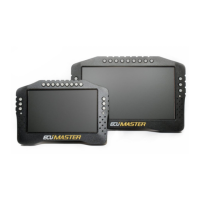the application (CTRL + F)
Upgrade firmware... Update the internal software of the device
Restore to defaults Restore a device to the default settings Deletes all settings
Make permanent Saves changes to the Flash memory of a device Additionally, a file
containing the current settings is saved to the
MyDocuments/ADU/DeviceName/QuickSave catalogue (F2)
Exit Exit the application. The desktop arrangement is saved upon exiting
(ALT + X)
Edit
Undo Undo the most recent operation (CTRL+Z)
Redo Redo a previously undone operation (CTRL+Y)
Show undo list Displays a pane with all operations performed
Toggle debug log Displays the console logging the program operations (SHIFT + F9)
Desktops
Restore desktops Reads desktops layout from
MyDocuments/ADU/Default/desktops.adulayout file
Store desktops Saves desktops layout to
MyDocuments/ADU/Default/desktops.adulayout file
Open desktop
templates...
Reads desktop configurations to a selected file. This allows to
transfer configurations between computers
Save desktop
templates...
Saves desktop configurations to a selected file. This allows to
transfer configurations between computers
Add new pane Adds a new pane to the desktop (F9)
Switch to desktop This option allows to switch between desktops
Previous desktop Switch back to the previous desktop (CTRL+PGUP)
Next desktop Switch to the next desktop (CTRL+PGDWN)
Devices
Device selector If one or more ADU devices are connected, a pane enabling
switching between the devices will pop up. After switching to a
device, the data between the PC and the device will be automatically
synchronized. The names of particular devices are shown on the
right hand side of the application toolbar. The currently connected
device is shown in bold type
Set device #n Automatic switching to the connected device no. #n. After switching
to a device, the data between the PC and the device will be
automatically synchronized. The names of particular devices are
shown on the right hand side of the application’s toolbar. The
Page 34/137

